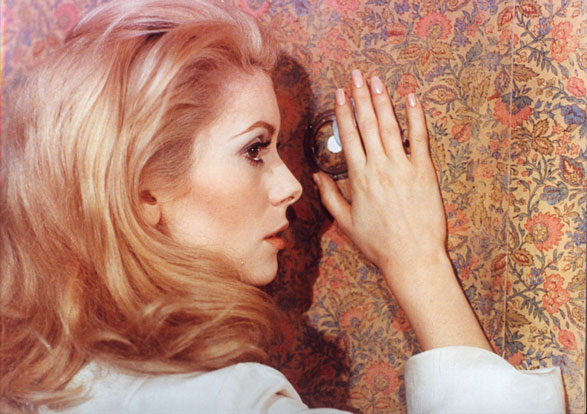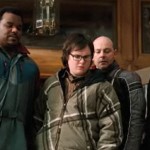The first thing you see in Belle de jour is a long stretch of rural road in a French country scene so impossibly picturesque it seems to belong in an art museum. A horse-drawn carriage approaches the camera slowly and eventually we see two uniformed coachmen driving while in the back the attractive and well-off couple Séverine (Catherine Deneuve) and Pierre Serizy (Jean Sorel) exchange sweet nothings. There’s no soundtrack, just diegetic sound including horses’ hooves and harness bells, sounds which will return during the film to signal shifts in Séverine’s psychological state.
This idyllic picture is shattered as the carriage comes to a stop and Pierre and the coachmen force Séverine out of the carriage. She is dragged across the forest, gagged, bound and stripped to the waist, after which the coachmen begin beating her with whips while Pierre looks on, smoking a cigarette. One of the coachmen takes off his coat and begins fondling Séverine (who somewhat surprisingly has a look of contentment on her face)—and then director Luis Buñuel cuts to an absolutely non-threatening Pierre in the bathroom of the couple’s comfortable Paris apartment, preparing to join Séverine in the couple’s bedroom. Only then do we realize that the opening scene was been a dream, or a daydream, which took place only in Séverine’s mind.
Buñuel will mislead us in a similar manner several more times over the course of the film. He deliberately avoids giving any sign to indicate the difference between a dream sequence and action in the shared world of the characters, allowing him to surprise us again and again. The film also includes several flashbacks which I believe are supposed to be depictions of real events but they could also be true in the sense that our memories our true to us (even if they never happened) or they could be purely imaginary.
Belle de jour is often described as a film about a middle-class housewife (Deneuve) who voluntarily becomes a prostitute, but that’s only true on a superficial level: the film’s true subject is the erotic power of the imagination as well as Buñuel’s favorite topic, the decadence and ridiculousness of the bourgeoisie. Power and role reversals are also a theme: certainly France was a man’s world, legally and financially, in 1967, but the female characters are running the show in this film while the men are frequently portrayed as clueless children.
We learn in the opening scenes that Séverine and Pierre do not have a sexually-functioning marriage: they sleep in separate beds and Pierre is obviously frustrated by the arrangement but it also pleases him to treat his wife as a virginal child. Séverine is also frustrated, but doesn’t know quite why. Unlike Pierre, however, she is motivated to seek an answer, which she finds after she begins working afternoons at a Paris brothel run by Madame Anais (Genevieve Page). Séverine she uses the pseudonym “Belle du jour” (“beauty of the day” or “day lily”) because she is insistent that she must leave by five o’clock every day to keep her husband from finding out what she is doing. She experiences a variety of customers but the one which will become crucial to the film’s denouement is a young gangster named Marcel (Pierre Clementi) who becomes obsessed with her and observes no boundaries in that obsession.
It would be a mistake to interpret Belle de jour entirely as a realistic film: it’s really more of a puzzle where you need to figure out when to interpret the action as realistic, when as symbolic, and how to put the two together. The dialogue is frequently stylized, as is the action and cinematography, and the characters’ clothing and surroundings underline both their emotional states and their class status. This makes Belle de jour a rich experience which retains its interest over repeated viewings. Just in case you were wondering, despite much of the action taking place in a brothel there’s no explicit sex in Belle de jour, and the film is stronger for it. After all, just about anyone old enough to be interested in this film already knows how it works: it’s everything other than the physical process which interests Buñuel.
Belle de jour was originally released in 1967 and won the Golden Lion at the Venice Film Festival that year. The Miramax DVD includes an informative commentary track by film scholar Julie Jones, the original U.S. theatrical trailer and the 1995 re-release trailer. Interestingly, both trailers include a cheesy soundtrack (the film itself has none) and (less surprisingly) play up the titillation factor. The soundtrack is available in the original French and in a badly dubbed English version with optional English subtitles and English captions for the hearing impaired (the latter tells you about nonverbal sounds like “bells jingling”).













